Korean war and Vietnam war: A comparative approach to cold war in Asia
After World War II, the world was formed into two different systems: capitalism and
socialism, leading to a new form of war - "Cold War". Although being called "Cold War," it was
manifested by "Hot Wars" such as those in Indochina and the Korean peninsula. The Korean War
(1950-1953) and the Vietnam War (1954-1975) were convergence points of confrontation between
the two systems. While both of the wars were partly an East-West conflict, they were also a
"North-South" conflict. This paper examines a reference by comparing the Korean War and the
Vietnam War from a perspective of the Cold War system. Due to developing differently in the
international, regional, and national contexts, the Korean War and the Vietnam War differed in
various dimensions. The article proposes the similarities and dissimilarities between the two wars
and how they still influence present historical issues
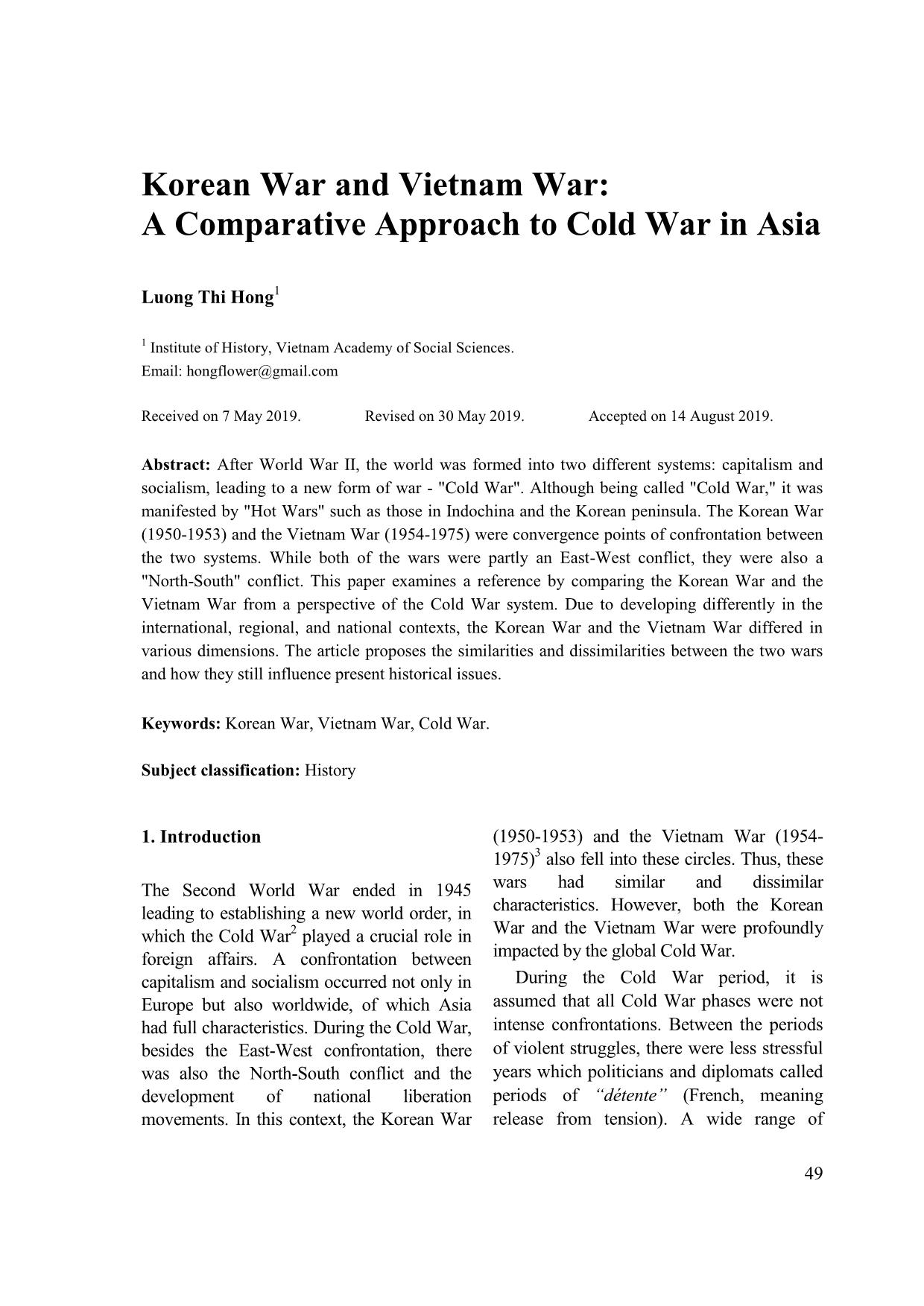
Trang 1
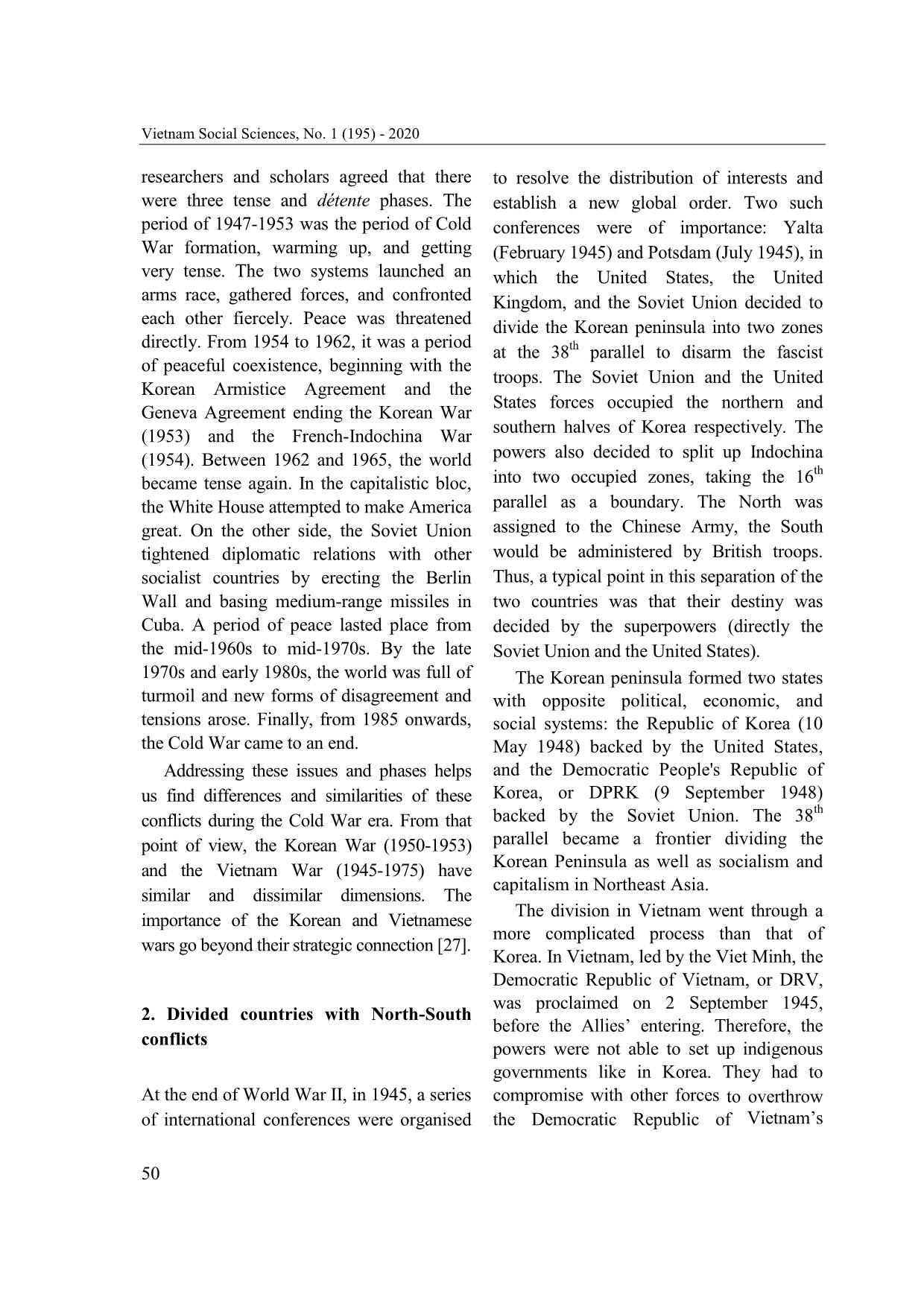
Trang 2
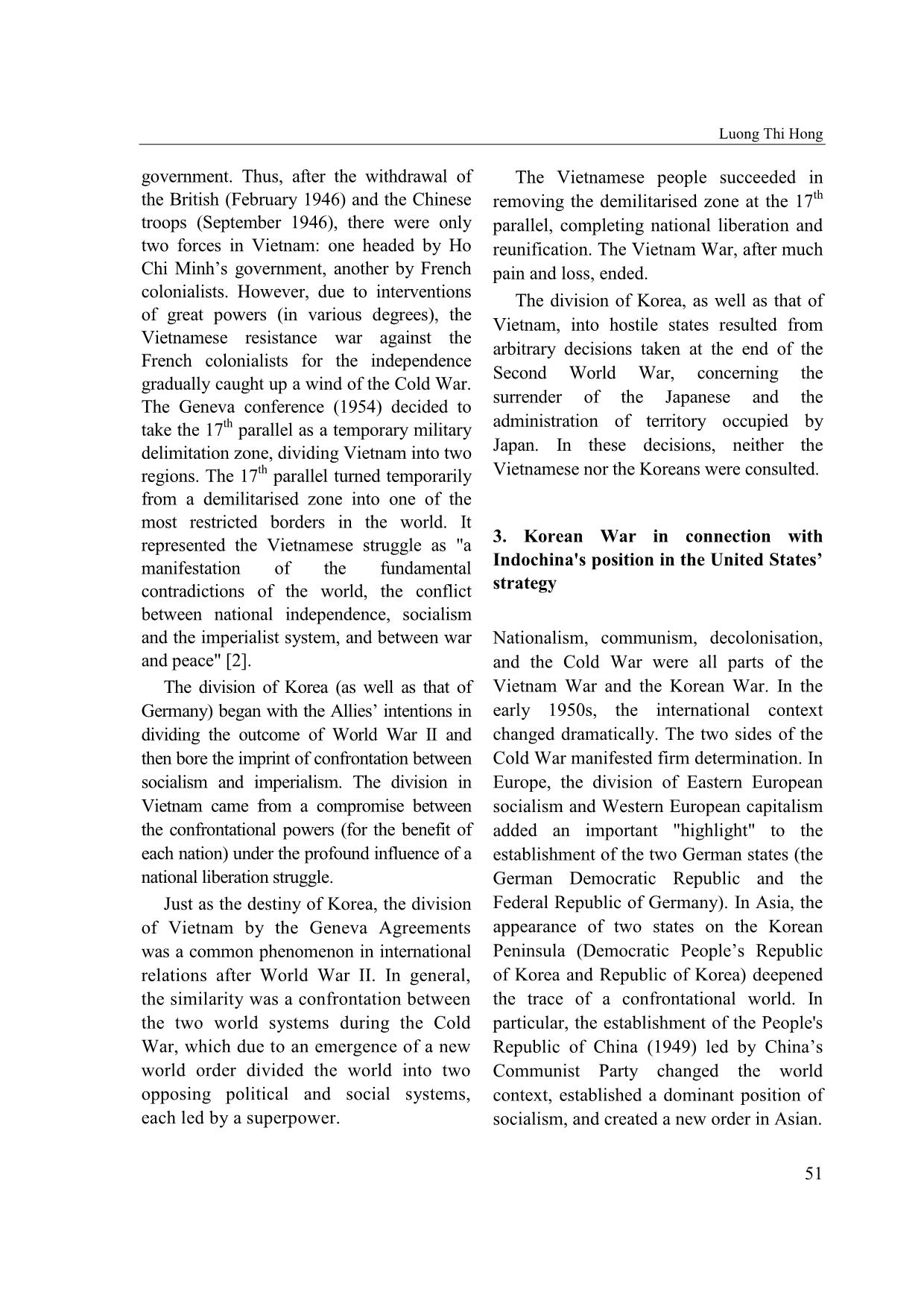
Trang 3
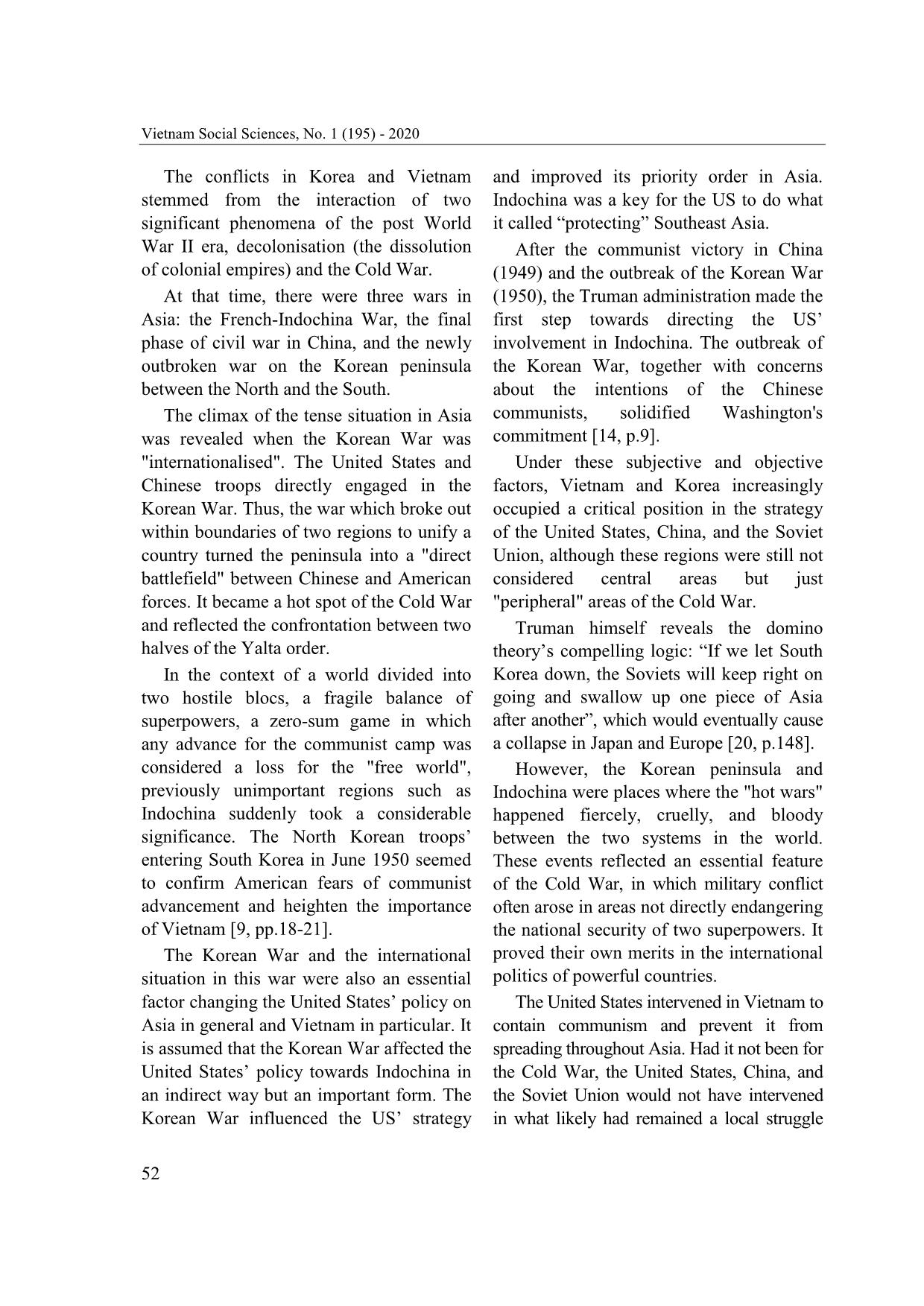
Trang 4
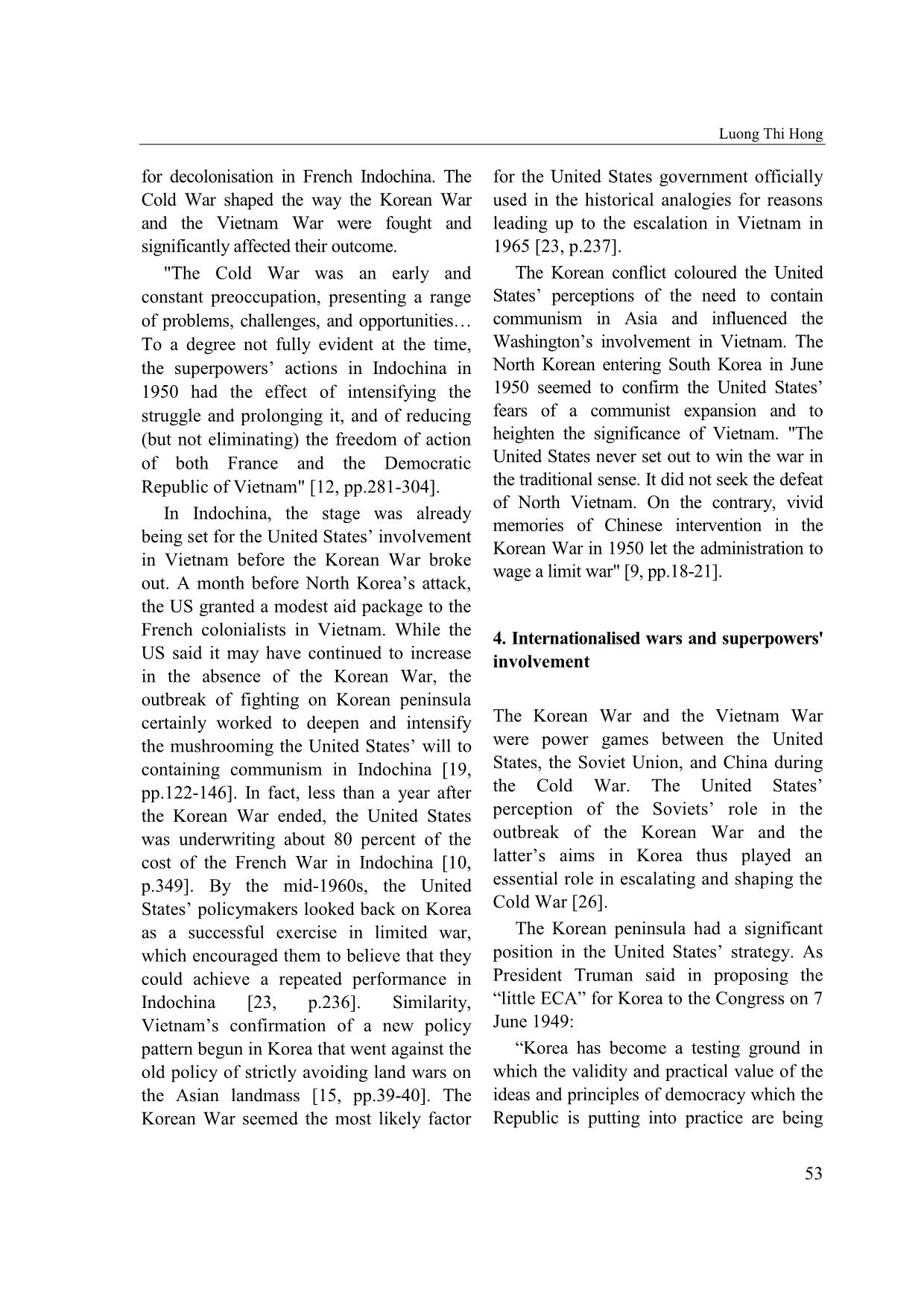
Trang 5
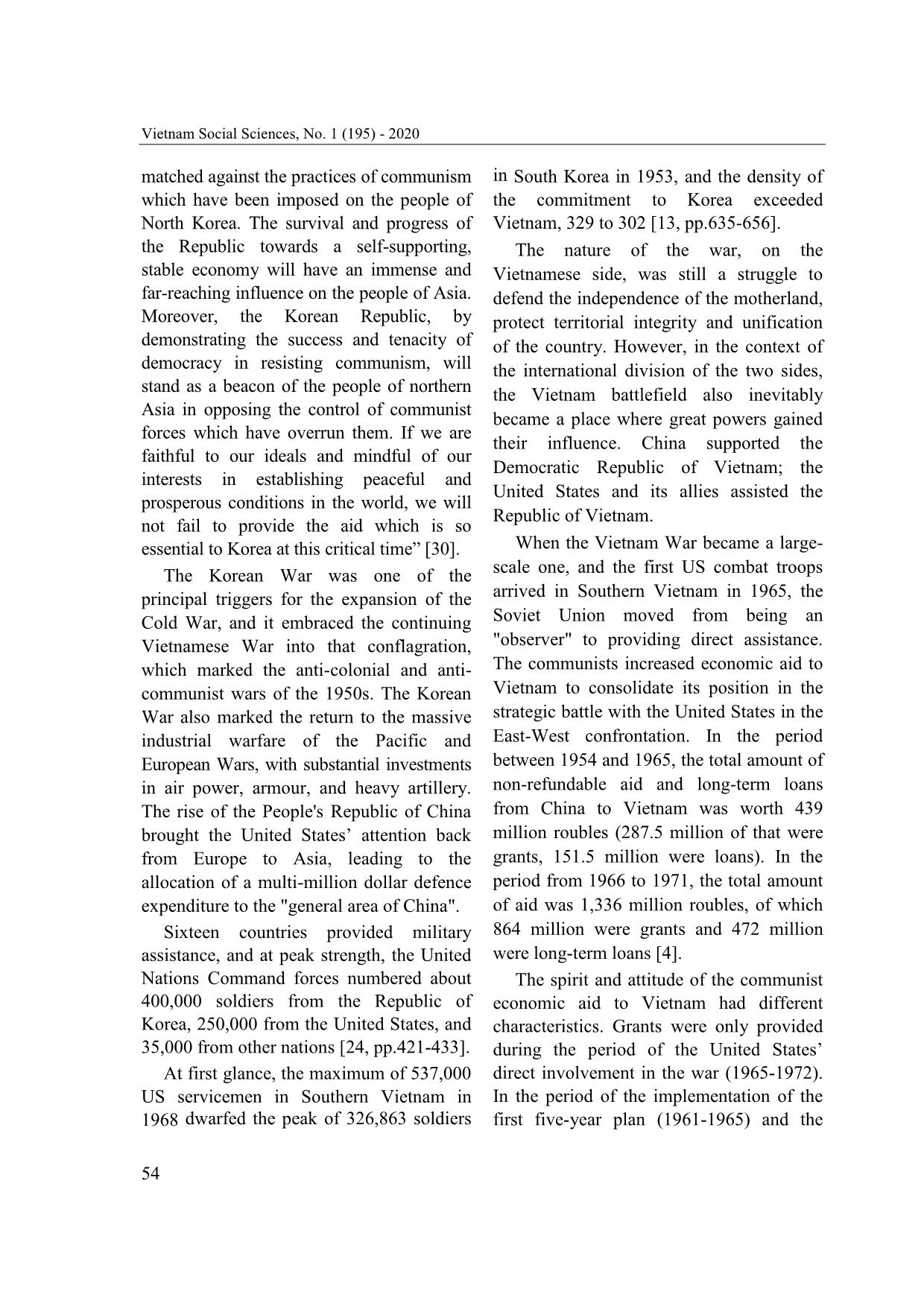
Trang 6
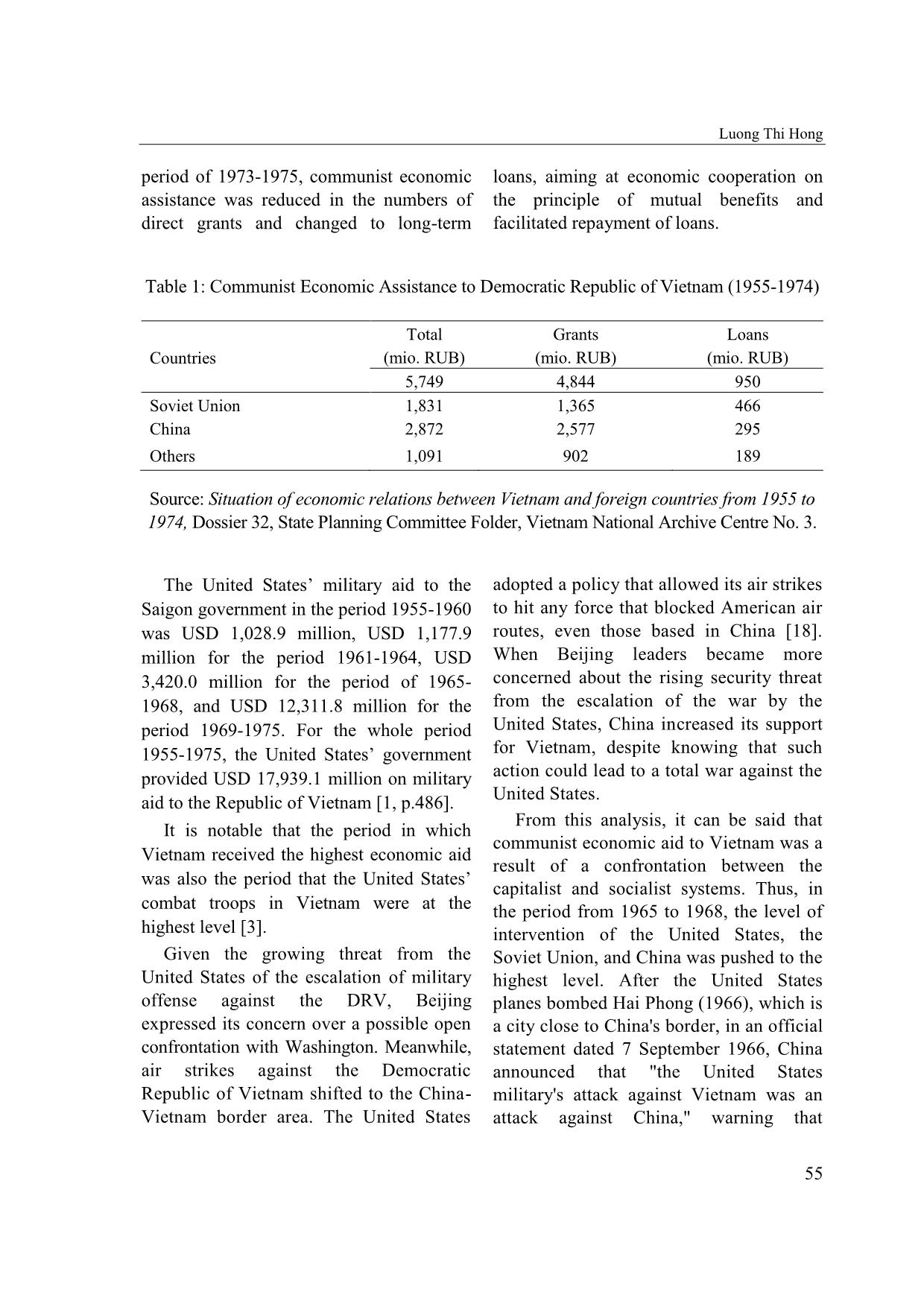
Trang 7
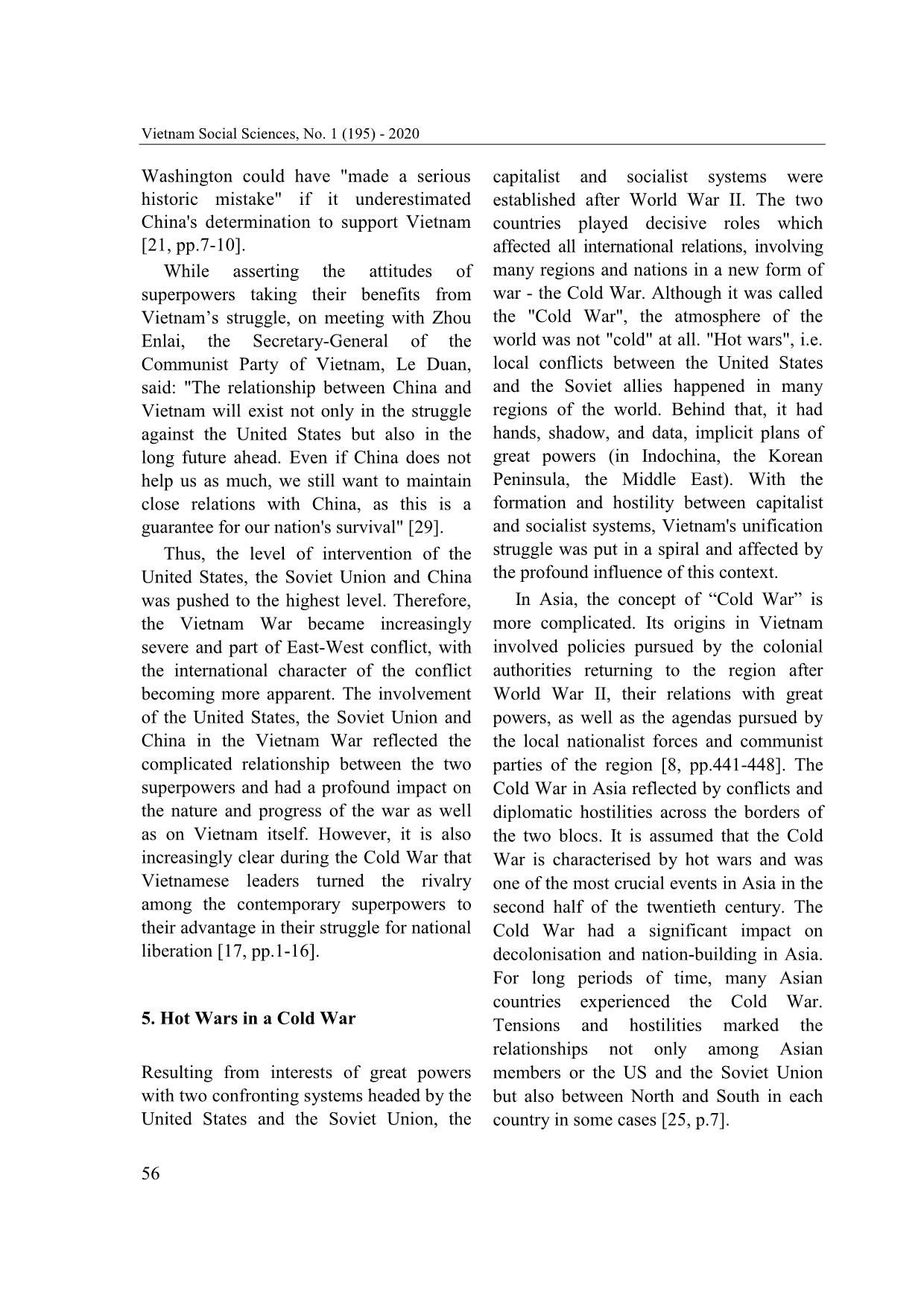
Trang 8
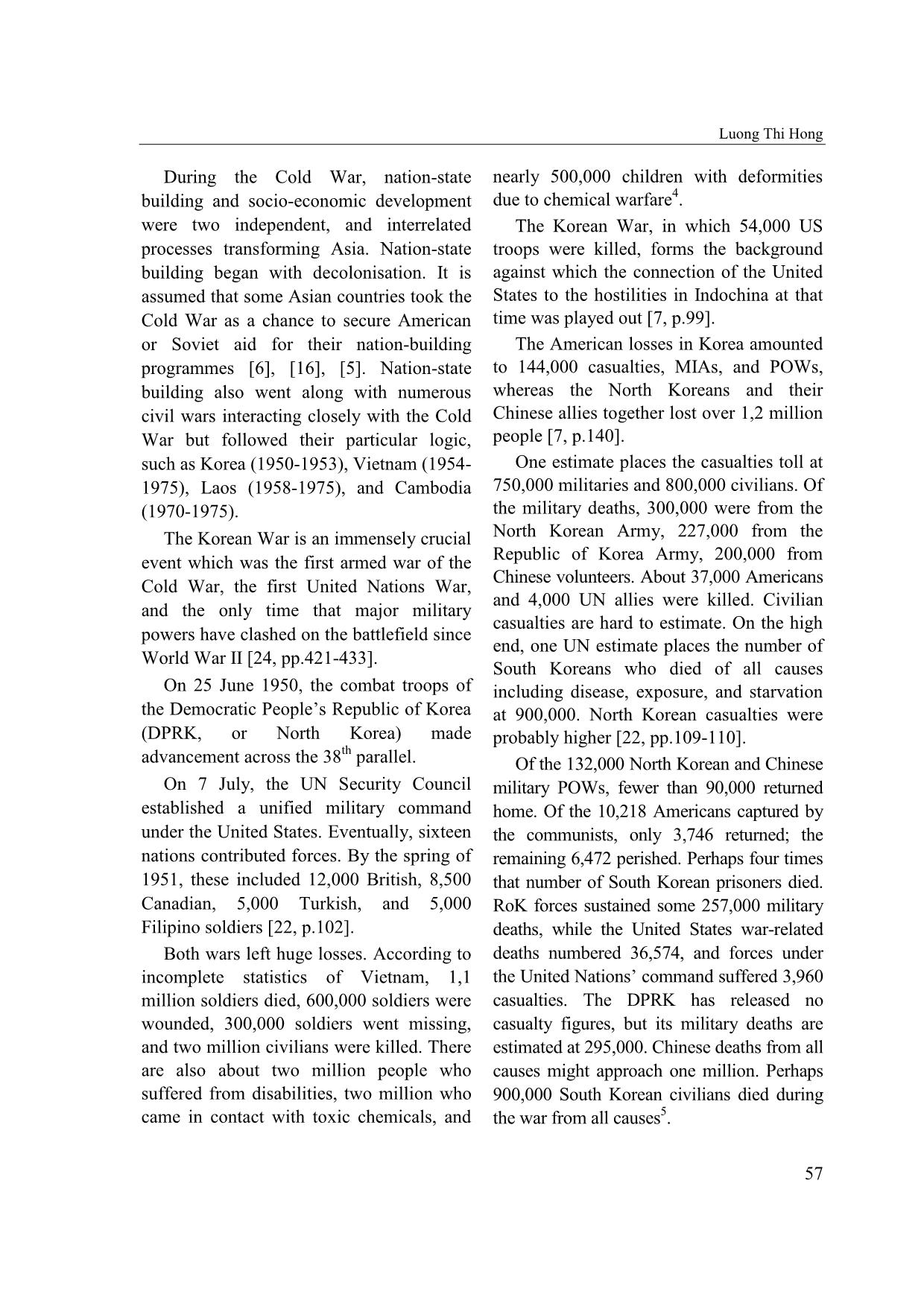
Trang 9
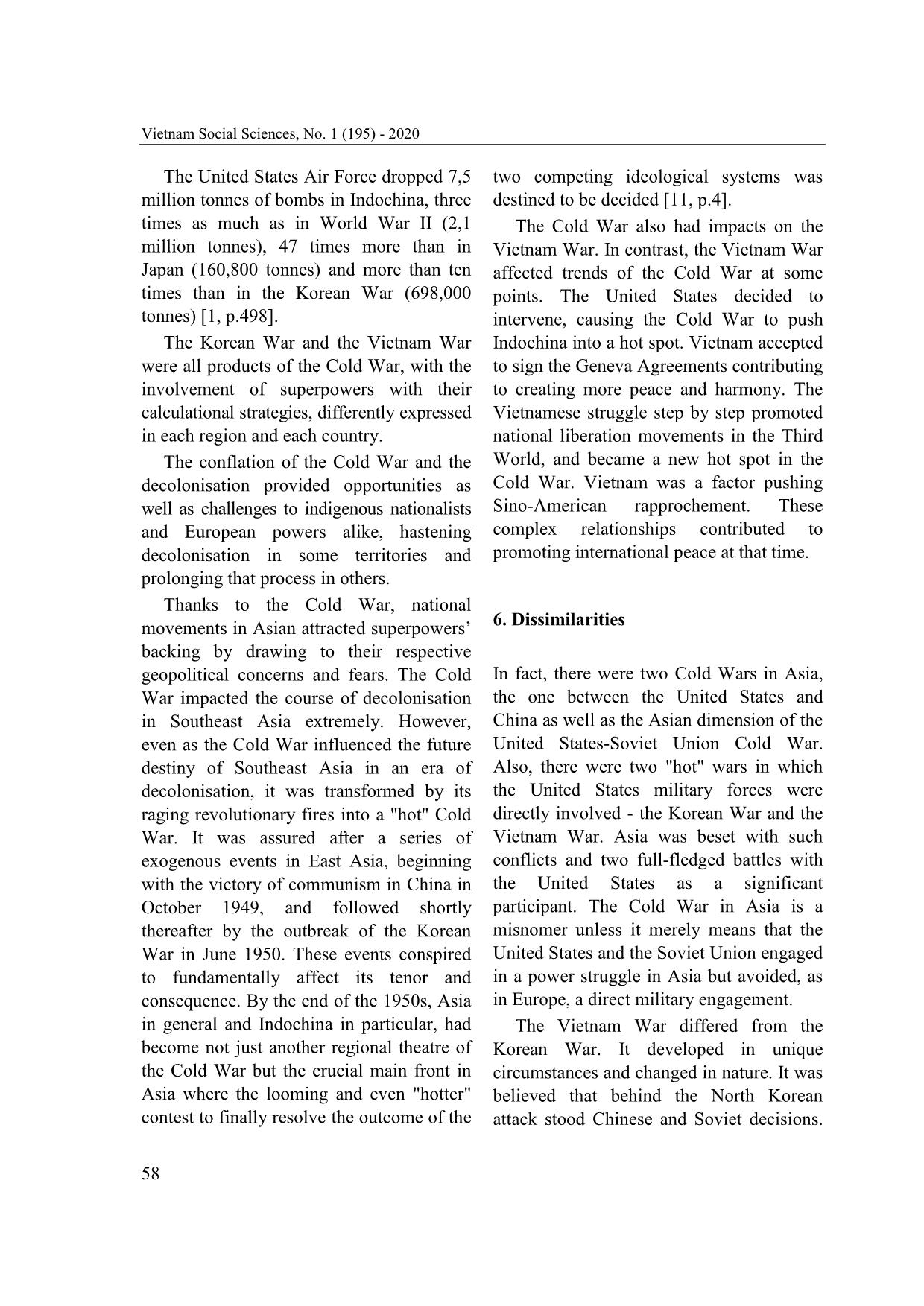
Trang 10
Tải về để xem bản đầy đủ
Tóm tắt nội dung tài liệu: Korean war and Vietnam war: A comparative approach to cold war in Asia
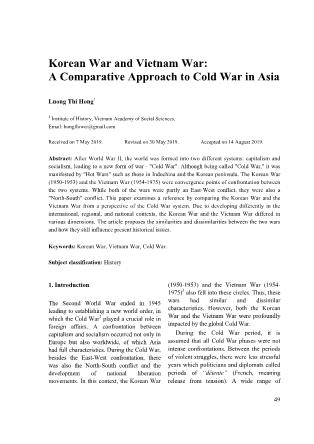
owers. This military ceasefire, but not a political confrontation related directly to the strategic resolution which resolved the issue of calculations of the United States, the Soviet national rights, including the unification of Union, and China and the involvement of the Korean peninsula. This is a fundamental these countries in these clashes. difference from the 1954 Geneva Due to the political situation and Agreements on Indochina. It is also the geographic features, the wars’ purposes were longest lasting armistice that should have different: The Vietnam War was a struggle to been replaced by a permanent peace treaty preserve unity and territorial integrity - a for the Korean Peninsula. The mutual fundamental part of national rights. The suspicion and the ideological opposition Korean War was a direct engagement between North and South Korea were both between the two confronting blocs, namely symbols of confrontation. The conflict of China, Korea, and the United States. It led to the Cold War had a profound effect on the different results that directly affected Korean peninsula. The two political regimes countries and regions in postwar years. in the two regions had two different In addition to its international character, ideologies, even opposing each other, so their the wars in Korea and Vietnams are North- perception was utterly different. South struggles. In both cases, the division The Korean War and the Vietnam War of the countries into two zones were differed in their nature and participants of significant reasons leading to the breakout the war. The Korean War happened in two of the war. The split led to a fierce phases. In the first phase, foreign allies did confrontation between the two regions, not have crucial roles. During the second 59 Vietnam Social Sciences, No. 1 (195) - 2020 phase, nearly 100,000 Chinese troops were However, the US escalation forced them to fighting against the forces of the United make tough choices to assist the DRV's Nations led by the United States. Thus, the efforts to reunify the nation. In total, the first phase was a local conflict. The second Soviet and Chinese aid estimated at more phase was an "internationalised" war on the than two billion USD. It helped to Korean peninsula. neutralise the United States’ air attacks, The Korean War occurred when the replace equipment lost in the bombings, East-West and the North-South conflicts and helped Hanoi to send more troops to were at the highest level, causing a bloody the South. "The fact that the Soviet and encounter. The result of the Korean battle Chinese supply almost all war material to was the Armistice Agreement, which meant Hanoi [has] enabled the North not ending the war. Vietnamese to carry on despite all our After the French failure to stabilise operations" [9, pp.18-21]. Indochina in 1954, the United States The Vietnam War exposed internal followed in the French footsteps and conflicts leading to a fierce struggle deployed their combat forces to contain the between two political regimes. After the spread of communism in Indochina. The Paris Agreement (January 1973), the United Vietnam War converted a part of the Cold States troops withdrew from Vietnam, with War, and the United States used Vietnam as the only remaining forces being a card to gain global strategic interests, and Vietnamese. The war characterised a civil to contain the influence of the Soviet Union conflict, but overall, it was a resistance to and China. The United States used all kinds unify the nation. of weapons to achieve victory. In contrast, At the same time, the Vietnam War Vietnamese people also accepted all occurred in the context of global bipolar hardship and sacrifice to gain their order. The North followed the socialist path independence, freedom, and reunification. supported by the Soviet Union, China, and For their obligations to allies, for their other socialist countries. The South interests, the Soviet Union, China, and followed the capitalist path with aid from other socialist countries assisted Vietnam in the United States and capitalist countries. this struggle. The peace and national Thus, the battlefield in Vietnam became the liberation movements fully supported confrontation between the ideologically Vietnam, including also American people. opposing systems. This situation led to the Thus, the French-Indochina war (1945- "internationalisation of the Vietnam War" 1954) and the Vietnam War (1954-1975) with the concern of the great powers. The were leading international events of great Vietnam War reflected challenges and attention for all humanity over an extended strength of both opposing sides. period. Whereas the Korean War (1950-1953) The Democratic Republic of Vietnam was a confrontation between the United took advantage of the Cold War in other States and the People's Republic of China, ways. Until 1964, both major communist the Vietnam War was only a direct combat powers had been consummate pragmatists. of the United States troops and its allies 60 Luong Thi Hong with Vietnamese forces in both regions. Meanwhile, American troops caused The Soviet Union and China strongly massacres, so they lost their loyalty and supported the DRV with regard to arms, public support back in the US as well as in ammunition, warfare facilities, expert many countries around the world. Thus, in teams, and anti-aircraft guards in some the United States, the anti-war movements northern provinces. Neither Soviet nor were calling for peace and unity. Chinese soldiers faced the United States and Saigon troops on the battlefield. Due to the characteristics of the situation 7. Conclusion and nature of the war, the Vietnamese struggle was associated with anti-war From these above mentioned points, it can movements all over the world. Vietnam be seen that the Vietnam War brought tried to gain support from all nations, simultaneously three characteristics which especially anti-war movements of American significantly differ from the Korean War: the people. Thus, Vietnam consolidated and national liberation of Vietnamese people, the expanded its global sphere, and built up the opposing between the two regimes in pressure on the United States’ government Northern and Southern Vietnam, the in the international, diplomatic, and military confrontation between the two blocs in the arenas. Therefore, Vietnam created its world. It solved the conflict between the legitimacy of the struggle. Vietnamese people and US imperialists, Although China and the Soviet Union between socialist and capitalist regimes, as supported Vietnam hugely, they could not well as the dispute between the Soviet Union control Vietnam's military and political and China. This split turned Vietnam into a policies. Hanoi determined its internal and place to win the other's influence. Thus, foreign affairs itself. Vietnam became a focus of the struggle not Since then, each war extended its only between the two blocs (capitalist and effects in various ways. The Vietnam War socialist) but also within the socialist camp. affected the non-aligned movements, However, the most significant difference receiving the support of people all over the between the Vietnam War and the Korean world. The Korean War did not have that War is the final outcome of this struggle. considerable influence. Despite being affected by the global Cold This difference created a political War, the Vietnamese people successfully advantage for the Democratic Republic of united the country. It was a result of the Vietnam, placing the conflict between the Vietnamese determination and sacrifices, Vietnamese struggle and the United States from which the Vietnamese Communist interference on the top. Therefore, the goal Party conducted the right leadership leading of the war was to fight against the to the success. Meanwhile, the Korean War aggression, to raise a banner of national was one of the bloodiest clashes in modern liberation, thereby uniting people, history and strongly influenced by external including a large number of people living factors. The split of the Korean Peninsula in the southern part of Vietnam. continues, and the remnants of the Second 61 Vietnam Social Sciences, No. 1 (195) - 2020 World War and the confrontation between 5 Casualty figures have been widely disputed, the the two sides in the Cold War have so far best analysis can be found in Allan R. Millet, not been resolved. Therefore, the Korean “Casualties”, Encyclopedia of the Korean War. peninsula remains in a state of being divided into two states. This division is a debt that the relevant powers need to be References responsible for towards the Korean people. Naturally, wars at any time, in any [1] Ban chỉ đạo tổng kết chiến tranh trực thuộc Bộ territory or country, mean losses and sad Chính trị (2015), Chiến tranh cách mạng Việt stories. The conflicts in Vietnam and Nam 1945-1975: Thắng lợi và bài học, Nxb Korea are very different, but they have this Chính trị quốc gia - Sự thật, Hà Nội. in common: as in warfare, it’s the civilians [Committee under the Politburo for Summing who suffered most of all. We should up National Revolutionary War (2015), remember the wars, not to repeat them but Vietnam's Revolutionary War, 1945-1975: instead maintain and consolidate peace as Victory and Lessons, National Political well as build up the friendship between Publishing House, Hanoi . people all over the world. [2] Đảng Cộng sản Việt Nam (2004), Văn kiện Đảng toàn tập, t.35, Nxb Chính trị quốc gia - Sự thật, Hà Nội. [Communist Party of Vietnam Notes (2004), The Complete Collection of Party Documents, Vol. 35, National Political Publishing 1 This paper was edited by Etienne Mahler. House, Hanoi . 2 The Cold War was defined in terms of the structure [3] Thông tấn xã Việt Nam (1973), Tài liệu về of international relations: the rivalry between the miền Nam. [Vietnam News Agency (1973), United States-led Western liberal democratic bloc Documents about the South]. and the Soviet-led Eastern communist bloc which [4] Trung tâm Lưu trữ Quốc gia III, Phông Phủ shaped the basic structure of international relations tướng, Hồ sơ 8767, Báo cáo về tình hình viện (Tadashi Aruga – Professor, Hitotsubashi University trợ kinh tế và kỹ thuật của Trung Quốc cho - The Cold War in Asia). Việt Nam từ 1955 đến 2/1970. [Vietnam 3 There are some arguments about the date of the National Archive Centre No. 3, Prime Minister "Vietnam War" which was also called "the Second Folder, Dossier 8767, Report on Chinese Indochina War" (1954-1975) or "the Vietnam Wars Economic and Technical Assistance to (1945-1975) (including the first and the second Vietnam from 1955 to February 1970 . Indochina war). In this paper, the author uses the term [5] Ragna Boden (2008), “Cold War Economics: “Vietnam War (1954-1975)” to refer to all the wars Soviet Aid to Indonesia”, Journal of Cold War happening in Vietnam’s territory during this timeframe. Studies, Vo. 10, No. 3. 4 The number was calculated based on that of people [6] Gregg A. Brazinsky (2007), Nation Building in receiving social welfare from the government. The South Korea: Koreans, Americans, and the real numbers of deaths and wounded people go far Making of a Democracy, University of North beyond [1, pp.576-580]. Carolina Press. 62 Luong Thi Hong [7] Frank Cain (2017), America's Vietnam War and [21] Peking Review, September 16, 1966. Its French Connection, Routledge, New York. [22] Michael J. Seth (2010), A Concise History of [8] Karl Hack, Geoff Wade (2009), "The Origins Modern Korea: From the Late Nineteenth of the Southeast Asian Cold War", Journal of Century to the Present, Rowman and Southeast Asian Studies, Vol. 40, No. 3. Littlefield Publishers, Inc, United Kingdom. [9] George C. Herring (2004), “The Cold War and [23] William Stueck (2002), Rethinking the Korean Vietnam”, OAH Magazine of History, Vol. 18, War: A New Diplomatic and Strategic History, No. 5. Princeton University Press. [10] Burton I. Kaufman (1986), The Korean War: [24] Spencer C. Tucker (2010), “The Korean War, Challenges in Crisis, Credibility, and 1950-1953: from Maneuver to Stalemate”, Command, Temple University Press. The Korean Journal of Defense Analysis, Vol. [11] Albert Lau (2012), Southeast Asia and the 22, No. 4. Cold War, Routledge. [25] Tuong Vu, Wasana Wongsurawat (2009), [12] Melvyn P. Leffler and Odd Arne Westad (2010), History of the Cold War, Vol II: Crises Dynamics of the Cold War in Asia - Ideology, and Détente, Cambridge University Press. Identity, and Culture, Palgrave Macmillan. [13] John L. Linantud (2008), "Pressure and [26] Kathryn Weathersby (2011), Soviet Aims in Protection: Cold War Geopolitics and Nation- Korea and the Origins of the Korean War, Building in South Korea, South Vietnam, 1945-1950: New Evidence from Russian Philippines, and Thailand", Geopolitics, Vol. Archives, Working Paper No. 8, Cold War 13, No. 4. International History Project. [14] Fredrick Logevall (2013), The Origins of the [27] Mel Gurtov (2010), "From Korea to Vietnam: Vietnam War, Routledge. The Origins and Mindset of Postwar U.S. [15] Callum A. MacDonald (1986), Korea: The War Interventionism", The Asia-Pacific Journal, Vol. before Vietnam, The MacMillan Press Ltd. 8, Issue 42, No. 1, https://apjjf.org/-Mel-Gurtov/ [16] Matthew Masur (2009), “Exhibiting Signs of 3428/article.pdf, retrieved on 26 May 2019. Resistance: South Vietnam’s Struggle for [28] Allan R. Millet, Korean War (1950-1953), Legitimacy, 1954-1960”, Diplomatic History, Encyclopedia Britannica, https://www.britannica. Vol. 33, No. 2. com/event/Korean-War, retrieved on 26 May [17] Edward Miller and Tuong Vu (2009), "The 2019. Vietnam War as a Vietnamese War: Agency [29] Wilson Center (1966), “Discussion between and Society in the Study of the Second Zhou Enlai, Deng Xiaoping, Kang Sheng, Le Indochina War", Journal of Vietnamese Studies, Vol. 4, No. 3. Duan and Nguyen Duy Trinh”, History and Public Policy Program Digital Archive, CWIHP [18] New York Times, April 27, 1966. Working Paper 22, "77 Conversations", [19] Michael J. Nojeim (2006), "US Foreign Policy and the Korean War", Asian Security, No. 2 (2). t/113071, retrieved on 26 May 2019. [20] Arnold A. Offner (1999), "Another Such Victory: President Truman, American Foreign [30] https://www.trumanlibrary.org/whistlestop/stu Policy and the Cold War", Diplomatic History, dy_collections/korea/large/documents/B43_18 Vol. 23, No. 2. -04_03.jpg, retrieved on 26 May 2018. 63
File đính kèm:
 korean_war_and_vietnam_war_a_comparative_approach_to_cold_wa.pdf
korean_war_and_vietnam_war_a_comparative_approach_to_cold_wa.pdf

